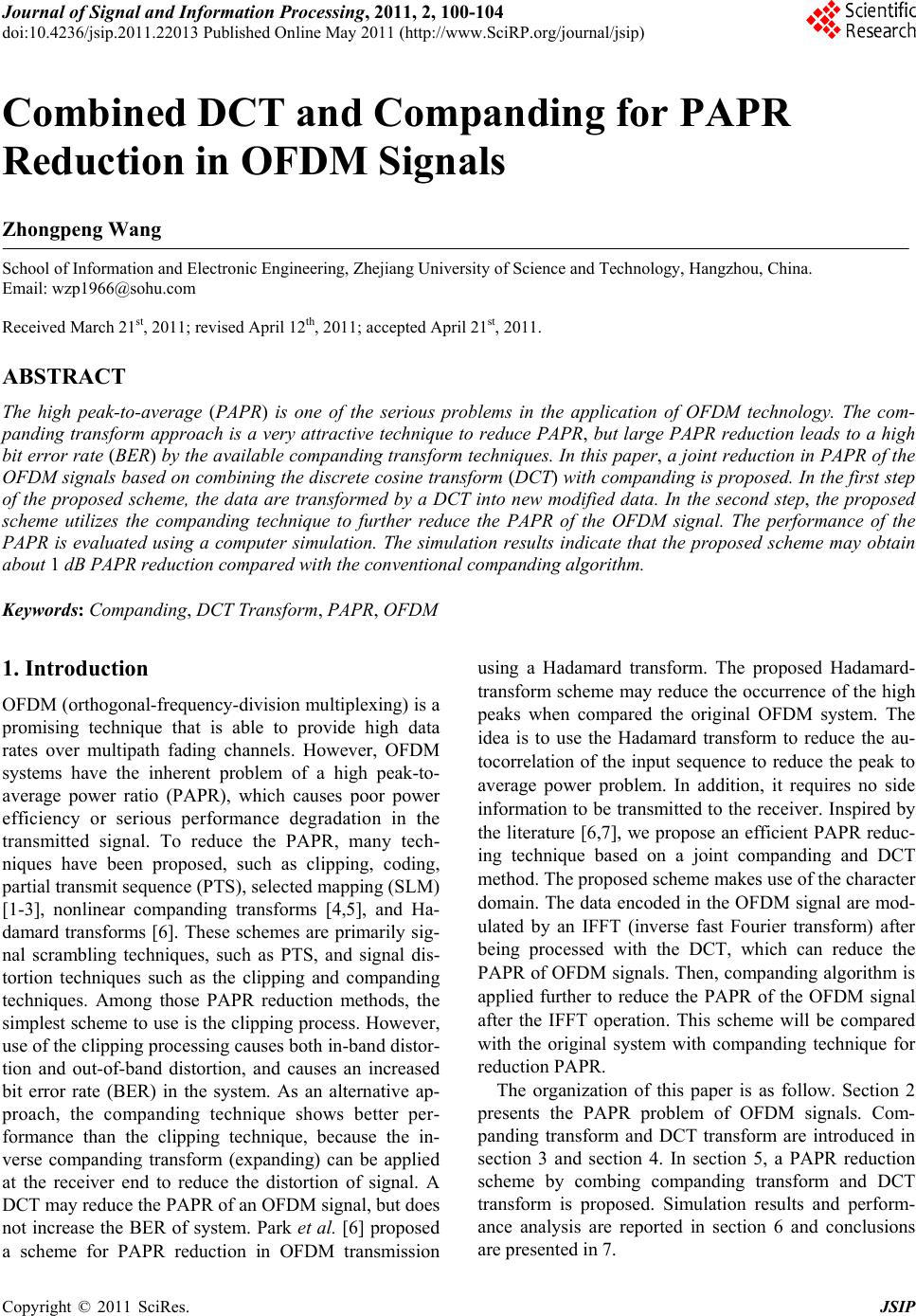
Journal of Signal and Information Processing, 2011, 2, 100-104
doi:10.4236/jsip.2011.22013 Published Online May 2011 (http://www.SciRP.org/journal/jsip)
Copyright © 2011 SciRes. JSIP
Combined DCT and Companding for PAPR
Reduction in OFDM Signals
Zhongpeng Wang
School of Information and Electronic Engineering, Zhejiang University of Science and Technology, Hangzhou, China.
Email: wzp1966@sohu.com
Received March 21st, 2011; revised April 12th, 2011; accepted April 21st, 2011.
ABSTRACT
The high peak-to-average (PAPR) is one of the serious problems in the application of OFDM technology. The com-
panding transform approach is a very attractive technique to reduce PAPR, but large PAPR reduction leads to a high
bit error rate (BER) by the available companding transform techniques. In this paper, a joint reduction in PAPR of the
OFDM signals based on combining the discrete cosine transform (DCT) with companding is proposed. In the first step
of the proposed scheme, the data are transformed by a DCT into new modified data. In the second step, the proposed
scheme utilizes the companding technique to further reduce the PAPR of the OFDM signal. The performance of the
PAPR is evaluated using a computer simulation. The simulation results indicate that the proposed scheme may obtain
about 1 dB PAPR reduction compared with the conventional compand ing algorithm.
Keywords: Companding, DCT Transform, PAPR, OFDM
1. Introduction
OFDM (orthogonal-frequency-division multiplexing) is a
promising technique that is able to provide high data
rates over multipath fading channels. However, OFDM
systems have the inherent problem of a high peak-to-
average power ratio (PAPR), which causes poor power
efficiency or serious performance degradation in the
transmitted signal. To reduce the PAPR, many tech-
niques have been proposed, such as clipping, coding,
partial transmit sequence (PTS), selected mapping (SLM)
[1-3], nonlinear companding transforms [4,5], and Ha-
damard transforms [6]. These schemes are primarily sig-
nal scrambling techniques, such as PTS, and signal dis-
tortion techniques such as the clipping and companding
techniques. Among those PAPR reduction methods, the
simplest scheme to use is the clipping process. However,
use of the clipping processing causes both in-band distor-
tion and out-of-band distortion, and causes an increased
bit error rate (BER) in the system. As an alternative ap-
proach, the companding technique shows better per-
formance than the clipping technique, because the in-
verse companding transform (expanding) can be applied
at the receiver end to reduce the distortion of signal. A
DCT may reduce the PAPR of an OFDM signal, but does
not increase the BER of system. Park et al. [6] proposed
a scheme for PAPR reduction in OFDM transmission
using a Hadamard transform. The proposed Hadamard-
transform scheme may reduce the occurrence of the high
peaks when compared the original OFDM system. The
idea is to use the Hadamard transform to reduce the au-
tocorrelation of the input sequence to reduce the peak to
average power problem. In addition, it requires no side
information to be transmitted to the receiver. Inspired by
the literature [6,7], we propose an efficient PAPR reduc-
ing technique based on a joint companding and DCT
method. The proposed scheme makes use of the character
domain. The data encoded in the OFDM signal are mod-
ulated by an IFFT (inverse fast Fourier transform) after
being processed with the DCT, which can reduce the
PAPR of OFDM signals. Then, companding algorithm is
applied further to reduce the PAPR of the OFDM signal
after the IFFT operation. This scheme will be compared
with the original system with companding technique for
reduction PAPR.
The organization of this paper is as follow. Section 2
presents the PAPR problem of OFDM signals. Com-
panding transform and DCT transform are introduced in
section 3 and section 4. In section 5, a PAPR reduction
scheme by combing companding transform and DCT
transform is proposed. Simulation results and perform-
ance analysis are reported in section 6 and conclusions
are presented in 7.